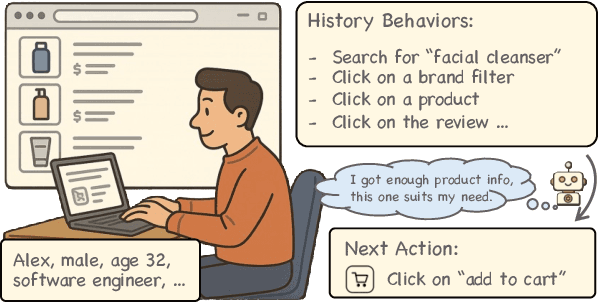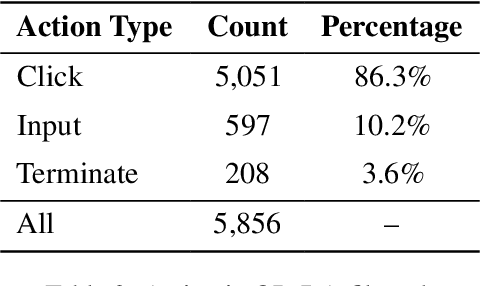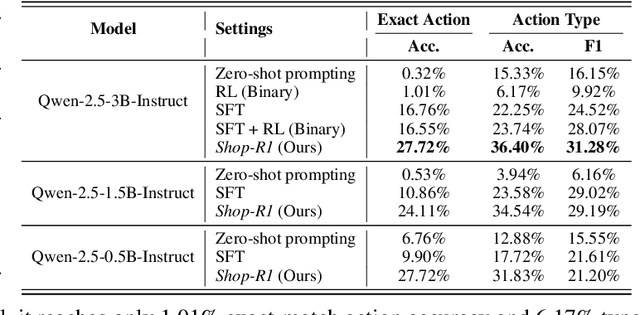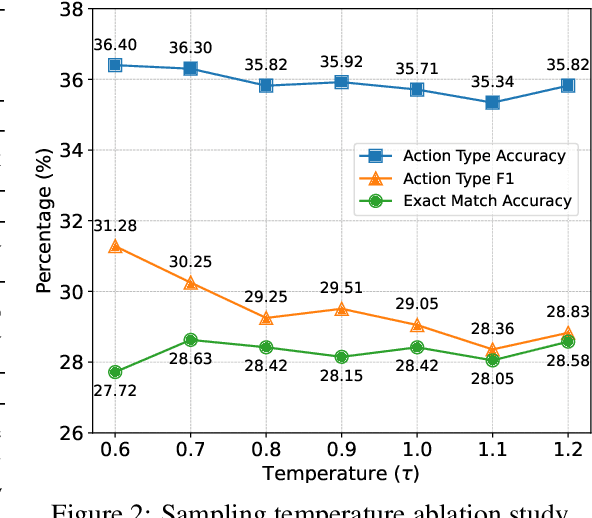Yimeng Zhang
The Universal Landscape of Human Reasoning
Oct 24, 2025Abstract:Understanding how information is dynamically accumulated and transformed in human reasoning has long challenged cognitive psychology, philosophy, and artificial intelligence. Existing accounts, from classical logic to probabilistic models, illuminate aspects of output or individual modelling, but do not offer a unified, quantitative description of general human reasoning dynamics. To solve this, we introduce Information Flow Tracking (IF-Track), that uses large language models (LLMs) as probabilistic encoder to quantify information entropy and gain at each reasoning step. Through fine-grained analyses across diverse tasks, our method is the first successfully models the universal landscape of human reasoning behaviors within a single metric space. We show that IF-Track captures essential reasoning features, identifies systematic error patterns, and characterizes individual differences. Applied to discussion of advanced psychological theory, we first reconcile single- versus dual-process theories in IF-Track and discover the alignment of artificial and human cognition and how LLMs reshaping human reasoning process. This approach establishes a quantitative bridge between theory and measurement, offering mechanistic insights into the architecture of reasoning.
See, Think, Act: Online Shopper Behavior Simulation with VLM Agents
Oct 22, 2025Abstract:LLMs have recently demonstrated strong potential in simulating online shopper behavior. Prior work has improved action prediction by applying SFT on action traces with LLM-generated rationales, and by leveraging RL to further enhance reasoning capabilities. Despite these advances, current approaches rely on text-based inputs and overlook the essential role of visual perception in shaping human decision-making during web GUI interactions. In this paper, we investigate the integration of visual information, specifically webpage screenshots, into behavior simulation via VLMs, leveraging OPeRA dataset. By grounding agent decision-making in both textual and visual modalities, we aim to narrow the gap between synthetic agents and real-world users, thereby enabling more cognitively aligned simulations of online shopping behavior. Specifically, we employ SFT for joint action prediction and rationale generation, conditioning on the full interaction context, which comprises action history, past HTML observations, and the current webpage screenshot. To further enhance reasoning capabilities, we integrate RL with a hierarchical reward structure, scaled by a difficulty-aware factor that prioritizes challenging decision points. Empirically, our studies show that incorporating visual grounding yields substantial gains: the combination of text and image inputs improves exact match accuracy by more than 6% over text-only inputs. These results indicate that multi-modal grounding not only boosts predictive accuracy but also enhances simulation fidelity in visually complex environments, which captures nuances of human attention and decision-making that text-only agents often miss. Finally, we revisit the design space of behavior simulation frameworks, identify key methodological limitations, and propose future research directions toward building efficient and effective human behavior simulators.
Customer-R1: Personalized Simulation of Human Behaviors via RL-based LLM Agent in Online Shopping
Oct 08, 2025



Abstract:Simulating step-wise human behavior with Large Language Models (LLMs) has become an emerging research direction, enabling applications in various practical domains. While prior methods, including prompting, supervised fine-tuning (SFT), and reinforcement learning (RL), have shown promise in modeling step-wise behavior, they primarily learn a population-level policy without conditioning on a user's persona, yielding generic rather than personalized simulations. In this work, we pose a critical question: how can LLM agents better simulate personalized user behavior? We introduce Customer-R1, an RL-based method for personalized, step-wise user behavior simulation in online shopping environments. Our policy is conditioned on an explicit persona, and we optimize next-step rationale and action generation via action correctness reward signals. Experiments on the OPeRA dataset emonstrate that Customer-R1 not only significantly outperforms prompting and SFT-based baselines in next-action prediction tasks, but also better matches users' action distribution, indicating higher fidelity in personalized behavior simulation.
Empathy-R1: A Chain-of-Empathy and Reinforcement Learning Framework for Long-Form Mental Health Support
Sep 18, 2025Abstract:Empathy is critical for effective mental health support, especially when addressing Long Counseling Texts (LCTs). However, existing Large Language Models (LLMs) often generate replies that are semantically fluent but lack the structured reasoning necessary for genuine psychological support, particularly in a Chinese context. To bridge this gap, we introduce Empathy-R1, a novel framework that integrates a Chain-of-Empathy (CoE) reasoning process with Reinforcement Learning (RL) to enhance response quality for LCTs. Inspired by cognitive-behavioral therapy, our CoE paradigm guides the model to sequentially reason about a help-seeker's emotions, causes, and intentions, making its thinking process both transparent and interpretable. Our framework is empowered by a new large-scale Chinese dataset, Empathy-QA, and a two-stage training process. First, Supervised Fine-Tuning instills the CoE's reasoning structure. Subsequently, RL, guided by a dedicated reward model, refines the therapeutic relevance and contextual appropriateness of the final responses. Experiments show that Empathy-R1 achieves strong performance on key automatic metrics. More importantly, human evaluations confirm its superiority, showing a clear preference over strong baselines and achieving a Win@1 rate of 44.30% on our new benchmark. By enabling interpretable and contextually nuanced responses, Empathy-R1 represents a significant advancement in developing responsible and genuinely beneficial AI for mental health support.
Shop-R1: Rewarding LLMs to Simulate Human Behavior in Online Shopping via Reinforcement Learning
Jul 23, 2025



Abstract:Large Language Models (LLMs) have recently demonstrated strong potential in generating 'believable human-like' behavior in web environments. Prior work has explored augmenting training data with LLM-synthesized rationales and applying supervised fine-tuning (SFT) to enhance reasoning ability, which in turn can improve downstream action prediction. However, the performance of such approaches remains inherently bounded by the reasoning capabilities of the model used to generate the rationales. In this paper, we introduce Shop-R1, a novel reinforcement learning (RL) framework aimed at enhancing the reasoning ability of LLMs for simulation of real human behavior in online shopping environments Specifically, Shop-R1 decomposes the human behavior simulation task into two stages: rationale generation and action prediction, each guided by distinct reward signals. For rationale generation, we leverage internal model signals (e.g., logit distributions) to guide the reasoning process in a self-supervised manner. For action prediction, we propose a hierarchical reward structure with difficulty-aware scaling to prevent reward hacking and enable fine-grained reward assignment. This design evaluates both high-level action types and the correctness of fine-grained sub-action details (attributes and values), rewarding outputs proportionally to their difficulty. Experimental results show that our method achieves a relative improvement of over 65% compared to the baseline.
AI4Research: A Survey of Artificial Intelligence for Scientific Research
Jul 02, 2025Abstract:Recent advancements in artificial intelligence (AI), particularly in large language models (LLMs) such as OpenAI-o1 and DeepSeek-R1, have demonstrated remarkable capabilities in complex domains such as logical reasoning and experimental coding. Motivated by these advancements, numerous studies have explored the application of AI in the innovation process, particularly in the context of scientific research. These AI technologies primarily aim to develop systems that can autonomously conduct research processes across a wide range of scientific disciplines. Despite these significant strides, a comprehensive survey on AI for Research (AI4Research) remains absent, which hampers our understanding and impedes further development in this field. To address this gap, we present a comprehensive survey and offer a unified perspective on AI4Research. Specifically, the main contributions of our work are as follows: (1) Systematic taxonomy: We first introduce a systematic taxonomy to classify five mainstream tasks in AI4Research. (2) New frontiers: Then, we identify key research gaps and highlight promising future directions, focusing on the rigor and scalability of automated experiments, as well as the societal impact. (3) Abundant applications and resources: Finally, we compile a wealth of resources, including relevant multidisciplinary applications, data corpora, and tools. We hope our work will provide the research community with quick access to these resources and stimulate innovative breakthroughs in AI4Research.
The Dual Power of Interpretable Token Embeddings: Jailbreaking Attacks and Defenses for Diffusion Model Unlearning
Apr 30, 2025Abstract:Despite the remarkable generalization capabilities of diffusion models, recent studies have shown that these models can memorize and generate harmful content when prompted with specific text instructions. Although fine-tuning approaches have been developed to mitigate this issue by unlearning harmful concepts, these methods can be easily circumvented through jailbreaking attacks. This indicates that the harmful concept has not been fully erased from the model. However, existing attack methods, while effective, lack interpretability regarding why unlearned models still retain the concept, thereby hindering the development of defense strategies. In this work, we address these limitations by proposing an attack method that learns an orthogonal set of interpretable attack token embeddings. The attack token embeddings can be decomposed into human-interpretable textual elements, revealing that unlearned models still retain the target concept through implicit textual components. Furthermore, these attack token embeddings are robust and transferable across text prompts, initial noises, and unlearned models. Finally, leveraging this diverse set of embeddings, we design a defense method applicable to both our proposed attack and existing attack methods. Experimental results demonstrate the effectiveness of both our attack and defense strategies.
Can Large Language Models Understand You Better? An MBTI Personality Detection Dataset Aligned with Population Traits
Dec 17, 2024



Abstract:The Myers-Briggs Type Indicator (MBTI) is one of the most influential personality theories reflecting individual differences in thinking, feeling, and behaving. MBTI personality detection has garnered considerable research interest and has evolved significantly over the years. However, this task tends to be overly optimistic, as it currently does not align well with the natural distribution of population personality traits. Specifically, (1) the self-reported labels in existing datasets result in incorrect labeling issues, and (2) the hard labels fail to capture the full range of population personality distributions. In this paper, we optimize the task by constructing MBTIBench, the first manually annotated high-quality MBTI personality detection dataset with soft labels, under the guidance of psychologists. As for the first challenge, MBTIBench effectively solves the incorrect labeling issues, which account for 29.58% of the data. As for the second challenge, we estimate soft labels by deriving the polarity tendency of samples. The obtained soft labels confirm that there are more people with non-extreme personality traits. Experimental results not only highlight the polarized predictions and biases in LLMs as key directions for future research, but also confirm that soft labels can provide more benefits to other psychological tasks than hard labels. The code and data are available at https://github.com/Personality-NLP/MbtiBench.
ID-Patch: Robust ID Association for Group Photo Personalization
Nov 20, 2024



Abstract:The ability to synthesize personalized group photos and specify the positions of each identity offers immense creative potential. While such imagery can be visually appealing, it presents significant challenges for existing technologies. A persistent issue is identity (ID) leakage, where injected facial features interfere with one another, resulting in low face resemblance, incorrect positioning, and visual artifacts. Existing methods suffer from limitations such as the reliance on segmentation models, increased runtime, or a high probability of ID leakage. To address these challenges, we propose ID-Patch, a novel method that provides robust association between identities and 2D positions. Our approach generates an ID patch and ID embeddings from the same facial features: the ID patch is positioned on the conditional image for precise spatial control, while the ID embeddings integrate with text embeddings to ensure high resemblance. Experimental results demonstrate that ID-Patch surpasses baseline methods across metrics, such as face ID resemblance, ID-position association accuracy, and generation efficiency. Project Page is: https://byteaigc.github.io/ID-Patch/
Multi-Source EEG Emotion Recognition via Dynamic Contrastive Domain Adaptation
Aug 04, 2024



Abstract:Electroencephalography (EEG) provides reliable indications of human cognition and mental states. Accurate emotion recognition from EEG remains challenging due to signal variations among individuals and across measurement sessions. To address these challenges, we introduce a multi-source dynamic contrastive domain adaptation method (MS-DCDA), which models coarse-grained inter-domain and fine-grained intra-class adaptations through a multi-branch contrastive neural network and contrastive sub-domain discrepancy learning. Our model leverages domain knowledge from each individual source and a complementary source ensemble and uses dynamically weighted learning to achieve an optimal tradeoff between domain transferability and discriminability. The proposed MS-DCDA model was evaluated using the SEED and SEED-IV datasets, achieving respectively the highest mean accuracies of $90.84\%$ and $78.49\%$ in cross-subject experiments as well as $95.82\%$ and $82.25\%$ in cross-session experiments. Our model outperforms several alternative domain adaptation methods in recognition accuracy, inter-class margin, and intra-class compactness. Our study also suggests greater emotional sensitivity in the frontal and parietal brain lobes, providing insights for mental health interventions, personalized medicine, and development of preventive strategies.
 Add to Chrome
Add to Chrome Add to Firefox
Add to Firefox Add to Edge
Add to Edge